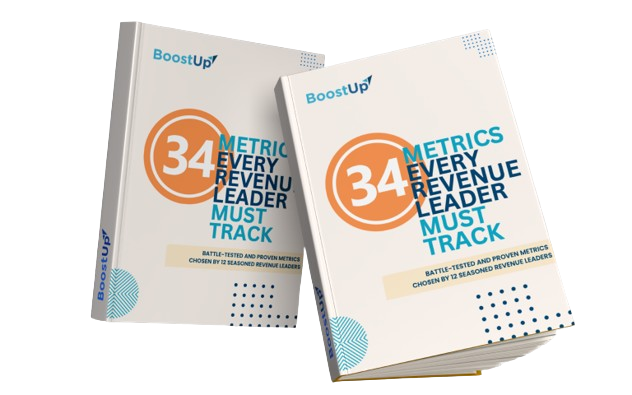Neel Kamal: Absolutely! The Revenue Maverick program is built for people who are looking forward to becoming you and have the wealth of information that you have. There are lots of revenue operators out there
Neel Kamal: who want to take companies from where you have taken - zero dollars to billions of dollars,
Neel Kamal: and in the process create lots of values for employees and shareholders.
Neel Kamal: As you have gone through this journey, it'll be great to hear from you some of the ways you run the business, some of the metrics you care about, and some of the wealth of knowledge you have gathered along the way.
Neel Kamal: Let's go through the slides that you have built to present those out for our audience.
Sean Burke: So Neel, I shared uh three different measurements that we use, and they all are for different reasons, but
Sean Burke: primarily as a leader of a revenue organization, what I look for for my numbers isn't always the answers, but where to dig in the business? So I can figure out where I nearly need to apply
Sean Burke: um, either some thought or some pressure in the business. So the 3 numbers that I chose to share for the revenue mavericks is number 1 - De-Lumping bookings,
Sean Burke: number 2 - war gaming in year revenue risk, and number 3 - investment weaponization. And we'll go through all three in detail, but just as a high level on each of these three, before we actually show the numbers,
Sean Burke: when I look at de-lumping bookings, one of the things that brought me to this number is that it's really important for us to have a consistent acquisition of new revenue throughout the quarter.
Sean Burke: In previous companies I've seen and in companies that I've talked to other CRO's with, is that
Sean Burke: you know up to 50% of their revenues or their bookings come at the last 2 weeks of the quarter, and that creates creates a ton of operational pressure on the business to respond on all that work that's accumulated in the last 2 weeks of the business, and what we're trying to do is spread out our ACV. So this measurement really helps me there.
Sean Burke: and then war gaming in-year revenue risk is we want to make sure that we try to project out, even starting in Q1, what our sales efforts will generate in-year revenue
Sean Burke: for the entire year. So we can project this early on in the year - what our revenue could be, and then match expenses. So if we're ahead on revenue,
Sean Burke: then we can increase investment. If we're we're lagging a little behind, then we may pull back on expenses until those get justified. But we really want to just have different scenarios that we play out in advance of them happening,
Sean Burke: and then finally, I call it investment weaponization. What this really came from is, I always ask my Revenue Ops team, I say - if I invest a dollar in our business, what's my return on investment? And then we just got really specific, like if I invested in region 1 or region 2 or region 3.
Sean Burke: And so this idea of investment weaponization really came from almost like I'm the investor in the company, and what's my return on the investment that we're putting in each of our regions? And then I use this to try to find best practices in our team. So that's that's the three measures we'll discuss today.
Neel Kamal: I love it. I especially love the way you've named them. You know often I say that you know revenue operations, meeting, or anything to will do with revenue gets too serious and too boring at times,
Neel Kamal: and we need to bring out the creativity, the fun factor, and you know the parallelization from another world. Certainly weaponization and war gaming is a parallelization from another world, but I love it. Let's go through them.
Sean Burke: By the way all the graphs that that we'll share today are not actual numbers, they're just representations of numbers, but they give everybody an idea
Sean Burke: of how that they could use these numbers within their own business. So let me draw everyone's eyes to the blue line going up into the right
Sean Burke: and the green line going up into the right.
Sean Burke: And so these are guidelines for us. Think of them as guardrails and what we want to see is that we're consistently bringing in
Sean Burke: ACV. So the the numbers represented in here would be ACV. and we have numbers that we want to hit over a quarter, so you'll see there's thirteen weeks at the bottom,
Sean Burke: and as we go throughout the quarter, what we want to see is how we're performing against these numbers every single week. So if you look from week 4 to week 5, something significant happened in week 4 to week 5.
Sean Burke: Obviously a good thing, but then, you know we flattened out and then and then peaked up at the end. So what this is really trying to tell me and and my other leaders are, are we operating within these boundaries? And if we ever, if we ever start to go below the boundaries, what do we need to do
Sean Burke: from a leadership team perspective to try to get them in these boundaries, and at the end of the the quarter what we want to see is the final numbers be within these ranges. By the way for us,
Sean Burke: being below our number is not great, and being too far above our number is not great, because we're really trying to run a tight business. And so if we crush your quarter, that's not good, because what that means is, we could have invested
Sean Burke: probably more in the quarter and other things, but we didn't until the quarter played out. So we we really want to do is fall somewhere within between these bands or around these bands, and you know we want to do that quarter after quarter.
Sean Burke: Not just one quarter, because, uh, you know, we want to run a consistent business. So let let me pause there and see if you have any questions about about this de lumping of booking. It's the only non military term we use being mavericks today, Neel, so it's It's kind of like the odd one out.
Neel Kamal: Yeah, but it is so on money because everybody have left the lumping problem. And you know the downscale implication of that, like you rightly said, is humongous of what you could have done with that. I am curious,
Neel Kamal: because a lot of your creativity here lies in creating this guardrails. How do you come up with these guardrails?
Sean Burke: So the first thing is you have to have,
Sean Burke: in general for me, about two years of very consistent data being used in your CRM in a consistent way. So
Sean Burke: you know, we did a lot of those hard, that hard work of saying you know, stage gating each one of our sales process lever so we know that you know to go from discovery to solution design to validation. You know that there's stage gates on that.
Sean Burke: The other thing that's, you know, different, more difficult for me than maybe others is I have a global organization. So even using terms globally to be able to do that. So the the first thing we needed to be able to do is
Sean Burke: is to have those those operating numbers. And then we looked at, you know, past years to see what we thought would be be something that could be appropriate. And then we also do a very extensive end of the year planning process, beginning of the year
Sean Burke: to try to give us these these guard rails so it's um, you know I couldn't couldn't do this in the company the first quarter that I joined. But typically after two years, you know, a good eight quarters of operating and operating consistently with the team on similar sales process,
Sean Burke: we could start doing it. And
Sean Burke: you know the first time that we ran this this out we were kinda up and down all over the quarter right, because it's the first time and you're learning, but over time what we're trying to get to is a normalization curve,
Sean Burke: and you know it's an ideal state, Neel, it's not like you can predict when a client is going to sign an agreement, or how things are going to go. But
Sean Burke: just the mindset of our sales team, knowing that we're trying to be predictable. And then also, we've even brought in like other teams that are impacted by us being consistent, like our implementation team. So they want us to be consistent because they don't want to get slammed at the end of the quarter having to do a ton of implementation. So
Sean Burke: it's It's a lot of you kind of dialing levers and working with teams like, really kind of get you there. But uh, that's how we've done it, and it's worked out really well for us. I think we're just now getting our our stride and being able to do this uh quarter after quarter.
Neel Kamal: Yeah,
Neel Kamal: I think part of this is just bringing attention to this problem, which is what I think this slide does. Earlier in my career. If I had focused so much around it, both I'll get appreciation from the team for trying to de-lump because you know, you can weaponize the straight line curve. And then the other thing here is that because the highest level of leadership is focused around it, you will see an effort from every facet of the organization. So this very well put together, Sean. I love it. Shall we go to the next one?
Sean Burke: Sure.
Sean Burke: So then, the next one is war gaming in year revenue risk and I realize there is a lot on this slide, so I think probably everyone who is watching this is trying to, you know, acclimate themselves to the slide. But
Sean Burke: before people try to do that, let me just kind of step back and and try to allow people to think through this versus look at the details. So,
Sean Burke: um for all of the revenue operations people that would be listening, and all those CRO's and the teams that are responsible for this.
Sean Burke: Not all ACV is the same,
Sean Burke: and not all ACV comes into your business and immediately turns to revenue the same way. A lot of companies really focus on ACV which is bookings, especially early in their their organization because their revenues are small. But when you get a mature organization,
Sean Burke: ACV's are great, because it shows that you're you're adding new revenue to the company, but most of my number is on revenue and EBITDA, so like ACV's are nice, but, like my plan is set up for revenue. And so what I want to know is
Sean Burke: is the mix of our new business,
Sean Burke: and how it's starting to come to fruition,
Sean Burke: generating enough in year revenue to allow us to hit our in your revenue. If you think of your revenue mix, you've got your core base of revenue
Sean Burke: you could take away from that churn, right, so always important to measure the churn, and then the in year revenue from the ACV that you get. And there's other things that you could look - upsells cross-sells, etc. So in our world we look at new logo, which is
Sean Burke: new business coming into the business - business that we did not bill last year,
Sean Burke: and then grow existing, and we assign ACV numbers to that. And so in your mind you can immediately think of well New Logo business probably drives more value from the company. It absolutely does, but it also takes longer to implement.
Sean Burke: While grow existing
Sean Burke: doesn't probably increase the value of the company as much, but you can get it much faster, and turn that into in-year revenue. And so so what we do is we take a look at different types of scenarios with the target. So in the first line, if we look kind of vertically um
Sean Burke: the target
Sean Burke: This is what we have the target for the year. So 27, again, example numbers let's just call like 28 million of new logo, almost 29 million of grow existing for a total of you know 56.25 million.
Sean Burke: And from that we're looking to generate 15.63 (million) of revenue this year. So if you miss Q1, you're done man. Q1 and Q2 are the most important quarters for you. And so then we just start to kind of war game
Sean Burke: based off of, you know, current pipeline right now look at if you take a look at our current pipeline example little lower on the new logo, higher on grow existing. If our conversion ratios play that way, and we hit the number,
Sean Burke: we'll actually come in at 107% of our in year revenue, because the mix of grow existing and new logo was was heavily favored in to grow existing. So in this case we achieved our goal, but we achieved more in in year revenue, because the mix was higher weighted towards grow existing.
Sean Burke: Um! Same thing. If we did another scenario where we even skew it more where you know New logo comes in at 17.5 million, which is the third area down and grow existing comes into 38, still hit the number,
Sean Burke: But this time you come in at 118% of your in year revenue versus the other scenario. And then you do the flip side of it, if we did more in new logo, say 42.5 million, and we really
Sean Burke: um fell short on grow existing we could still hit the ACV number, but in this scenario we only come in at 91% of our revenue goal,
Sean Burke: and then the last one is, if some of the timing of our business goes from, 1H is first half, If it moves from first half into second half, in this example we show still hitting the numbers, but only achieving 89% percent of our in-year revenue. So
Sean Burke: for for me as a leader, what I want to be tracking is almost kind of a tick sheet is what ACV did we close, and how much of that do we think is going to convert to in year revenue this year,
Sean Burke: knowing that new Logo is always going to be more risky than grow existing. So let me pause there, and and and we we could kind of do a little Q&A on this one.
Neel Kamal: In this scenario planning, let's say you like a particular scenario, what abilities do you deploy
Neel Kamal: to work on that scenario? Because are these hypothetical things written in each row? Or you have the ability to just selectively go after higher New logo, or higher existing client mix type of scenario.
Sean Burke: Well the first scenario, so the target is let's just say it's a budget at the beginning of the year. So it I mean everybody's perfect at the beginning of the year we're all doing really well.
Sean Burke: And then what we do even before the year starts we look at what the current pipeline mix is. So if we did nothing and change none of the "New"s. Then in this scenario we'd be at 107%. So quite likely in this scenario I'd be like just close what we have, and we’re fine.
Sean Burke: You know what I mean. We're in good shape, but as the year plays out, what I'm looking for is ups and downs, pushes and moves around to see if that mix of new logo
Sean Burke: and uh existing accounts starts to get off, because then we want to feed this to our finance team to say hey look,
Sean Burke: you know we're six weeks into the year right now we're ahead on ACV by 107%. If that changes, we also want to be able to educate or or tell the rest of the organization that we're tracking behind. And the reason why is this is a way for us to better within the year,
Sean Burke: try to change the outcome. So if I start to see
Sean Burke: a lot of new logo ACV come in and not grow existing. Guess who I'm talking to, I'm talking to our account directors to say, hey look, we're getting a lot of new logo, but you know, let's just say that we're getting new logo sales that happen in the third quarter, well guess what,
Sean Burke: we may not even see that revenue this year. So really, what I'm trying to do is just know, again, where to dig and where to kind of push the team, knowing that quite honestly after the the second quarter is over, maybe third quarter
Sean Burke: the in year revenue we're gonna get from New Logos is zero. So this really for me is a lot of pressure testing in Q1 and Q2 to make sure that I'm not sweating bullets in Q3 and Q4 and it allows me to, you know, work with my, because I have global leaders, some are new logo, some are
Sean Burke: um existing. Cast. It knows where I need to put a little bit more pressure on the business because we're falling below in certain numbers.
Neel Kamal: That's very interesting. Does this structure allow you to get a quorum decision?
Sean Burke: Well, it allows the team to work together. I wouldn't say It's a quorum decision. What it allows me to do is in my commercial leader meeting is people will call their shot,
Sean Burke: and when someone's low, then other team members will say hey look, I've got two million here, I've got three million here. So
Sean Burke: one of the things, and and by the way, a lot of these numbers are very culturally changing. Um, And they tell you a lot about your leadership because everybody struggles at least one quarter, and one of the things that's kind of nice about you know my leadership teams in the past is whenever somebody was having a bad quarter, there's already somebody else having a good quarter, and said I got you this quarter, but remember this because you know three quarters from now I could use your help.
Sean Burke: So I think more than decision making it lets us know where we need
Sean Burke: like optionality. So you know, if we can't get in from region one, how does region three or region four look. By the way, for me,
Sean Burke: a lot of times it tells me am I going to make it or not? Because we would inform the rest of our organization as early as possible, like one of our phrases is "bad news does not get better with time"
Sean Burke: is we want to be able to highlight to the company as early as possible in a quarter in the year how we're tracking to our numbers, because that revenue that you see in the far column
Sean Burke: can be used to reinvest in the business if we're tracking towards it. If we're following short of it, you know we want to manage our expenses against that. So it allows us to stay really keeps our you know, revenue expenses really tied closely, and if we're ahead, then we can invest more back into the commercial organization earlier in the year
Sean Burke: to get even more revenue and ACV you know, within the year that year, and subsequent years from there.
Neel Kamal: That is really nice. The downstream effect, or the unintended consequences of creating camaraderie within the team
Neel Kamal: because you're bringing such
Neel Kamal: calculation to them,
Neel Kamal: is just priceless I think. So yeah, Kudos! I love it!
Neel Kamal: all right. Let's go to our last one or next one.
Sean Burke: Okay, So the last slide is um.
Sean Burke: This is almost a philosophical slide and kind of going to the to the maverick idea.
Sean Burke: Ever since I was a young entrepreneur,
Sean Burke: using my own money in a lot of cases to start businesses, I mean, when you start your own business, you look at uh expense side numbers very differently than if you have investors.
Sean Burke: So what I like to do about once every half
Sean Burke: is to just look at my business and say across our different regions,
Sean Burke: If I were to put a dollar into a region, what is my return on investment, and what is my investment and output expense? It's almost, you know, kind of like a um.
Sean Burke: you know, How do we make sense of of the dollars that we're putting in. And so for me. Uh, if I look across these regions uh you can see, and by the way, they the kind of bluish purple bars are the sales expense,
Sean Burke: And then the purple line is expense as a percentage of revenue. So very quickly you can see region one
Sean Burke: very low expense as a percentage of revenue. And so what that tells me is, that I may be able to put a lot more dollars into region one because we're getting a pretty good return on that, compared to all of the other regions.
Sean Burke: Um, but it also tells me, is in region two and region four for some reason,
Sean Burke: their expense as a percentage of revenue is significantly higher than the other regions, and I want to dig in and know why. Now, by the way, Neil, I know why in each of these regions, one's the region that's newer and has lower revenue, and so their expenses should be higher
Sean Burke: than uh, you know, a mature team. But then there's another revenue that they expanded control, meaning their leadership to the amount of people that reported to them was lower. And so these are ways that I kind of look at and say, Hey, are we balancing the teams right, should we be putting more investment
Sean Burke: in other areas? And um! The other thing is, I report to a board, you know, four times a year and once a month, and so I never want them to ask me the question, like if I gave you X dollars, where would you put it?
Sean Burke: I want to have that answer already to go. So we do this exercise about once every six months because, you know, this isn't a measure that you need to look at every week. It it doesn't move that much. What I'm looking for is, you know, quarter over quarter, how is this working out, and then I also kind of compare it to budget. So I want to have this type of number created before we go into our budget planning uh for the end of the year. And and so um and it's super helpful. And by the way,
Sean Burke: it's another one of those team things where the team will come in it
Sean Burke: and and take a look at these numbers, and they say well how can I get more like region 1? I know that your listeners will now know is that region 1 has a massive base of revenue, their sales expenses as a percentage of revenue is likely always going to be lower. But I think for regions that are looking to grow, they can look at region 1 is to say hey once I'm a mature organization with larger revenues, I know that my sales expenses as a percentage of revenue could be less than
Sean Burke: you know 1% , most CRO's in my experience would love these type of numbers. You know a lot of, you know, early stage, you know it's 25%. So you know you're looking at a pretty mature organization here, you know, not a startup.
Neel Kamal: Right.
Neel Kamal: That makes sense. Would you also divide this not just based on regions, but product line? Um! It could be even lead sources right, depending upon where the opportunities are coming from, and so on, and so forth.
Sean Burke: So,
Sean Burke: product line we do not uh, we do not look at this type of information.
Sean Burke: Uh. So we we run our business with an OGSM model, which is, you know, objectives, goals, measures, strategies.
Sean Burke: And so for for product, what we look at is percentage of revenue from new products released. And we'll actually in our budgeting assigned product, a revenue number for a year for the new products that they come up with. So that's how we we handle
Sean Burke: those those areas. uh By lead source, the the type of information that we look for for lead source is really conversion ratios. We have an
Sean Burke: investment that's already kind of committed in SDR's to generate our leads, and we we're working with a relatively small TAM compared um not a small TAM in dollars, but in total accounts, because we service an industry that isn't like
Sean Burke: tens and thousands of of clients you like. If we took over the entire TAM of what we're doing, we're probably talking about two or three thousand accounts. Um,
Sean Burke: but our average, you know, average client's around a million dollars. So every one of those every new client that comes in is, is pretty significant for us. And so what I do look at is,
Sean Burke: I look at are we generating week over week enough pipeline to hit our conversion goals every single week, so I can tell are we tracking, and that ties into the first number that we saw, you know, if we're generating, you know. guard rails around the pipeline every week week over week, then,
Sean Burke: you know, hopefully in the out quarters will be generating ACV consistently week over week if we're all selling relatively similarly across the the the globe.
Neel Kamal: Yeah, I think the what I'm drawing from this slide is when presented information in in formats like this decision making becomes highly objective and extremely simple.
Neel Kamal: So this is
Neel Kamal: true to the word investment weaponization. When you weaponize it this way, you will get a right answer or an answer that everybody will see and agree to. Like there is no fluff in this uh, but in reality with in absence of data like this, we all know how
Neel Kamal: these decisions can become extremely hairy and very debated. Shall we go in EMEA now? Is it time to invest in APAC?Should we double down? and, you know, increase our presence/footprint on southwest?
Neel Kamal: These decisions are not easy, but I love the way you have brought data together to make that to to make that decision simple.
Sean Burke: Yeah, I think for me, what um,
Sean Burke: What I've learned is that
Sean Burke: you should always. If If you can set yourself up for success,
Sean Burke: then
Sean Burke: likely every CEO and every board
Sean Burke: we'll want to know
Sean Burke: what your thoughts are on how you have success faster,
Sean Burke: and as a leader, if you cannot have a data-driven discussion about that,
Sean Burke: uh, then you're you're, you're not as strong as you could be so. I always want to be able to answer that question before it's asked, and I also want to know for myself
Sean Burke: when I want to start asking for more budget, because then we can start to hit escalators and grow even faster as an organization. And I think a lot of this came from my early days of being an entrepreneur, where literally,
Sean Burke: you know, for weeks at a time I wasn't taking a paycheck, I was eating baloney sandwiches. I think that discipline from you know, being in my twenties, uh you know, running a a business with, you know three other people that, and we were broke, but we were growing. We were doubling in size every six months.
Sean Burke: It teaches you to to manage your investments wisely. And so this really helps me do that. The other thing is, I won't lie, It creates a little bit of competitive spirit within my team, because everybody wants to have
Sean Burke: you know, the lowest sales expense and the uh, the lowest sales expense as a percentage of revenue, or they want to, You know they want to, you know, kill some of the other charts um, and receive more investment. So this is something that really helps them know where they stand before they even ask me
Sean Burke: for any dollars to grow their team. I'm like well let's just take a look at the math and see what it tells us.
Neel Kamal: It's superb. I love it! Sean this is great!
Neel Kamal: So before I let you go.
Neel Kamal: I would love for you to have a message uh for our audience. These are people once again who want, who are revenue operators who wants to learn from you become like you do. You have recommendations from them. What should they do,
Neel Kamal: for years to come, to get to this level of mavericism?
Sean Burke: Thank you, Neel. Great question. And um, by the way, this is something that I write about on LinkedIn, I think in the last two weeks I wrote a post on this, so I'm going to stay true to what I write in the post, and I have some examples so like feel free to reach out to me directly on this.
Sean Burke: But in my mind there is a scale of revenue operations, um,
Sean Burke: leaders and operators.
Sean Burke: And um! If you can reach the highest scale, then you become,
Sean Burke: like the the second-hand person like I call it Moneyballing. Like my "Jonah Hill like Moneyballing." Not to say that I'm Brad Pitt, but Jonah Hill literally helps Brad Pitt make all of his decisions in that. And so the first one is, you can give your leader data, and I think the data is kind of man, it's like okay, great.
Sean Burke: What do I do with it? You know, not super helpful.
Sean Burke: What I really look for is for revenue operators to be able to use that data to provide insight. So, for example, they may say, Hey, we're under investing. Let's let's just use that last slide an example. We're under investing
Sean Burke: in region One. Okay, great. You know. The first question is, what should we be investing in? So the other so think about like
Sean Burke: like a top notch person is.
Sean Burke: Imagine a top notch revenue operator coming to me and saying, you know, Sean, right now we're under investing in region one by 4X, the investment amount. I think we could get an additional
Sean Burke: eight million dollars of ACV and two million dollars of in-year revenue, if we take our current investment from 1.2 million, and put it up to 2.2 million.
Sean Burke: Here's the data behind it. Here's my suggestions on how you ask it. Oh, by the way, I don't think that it will cause any of our other operating numbers to mess up, and I think this is something you should propose to the CEO of the board.
Sean Burke: Much different conversation than "we're under investing in an area." So what I would encourage all the revenue um operations leaders out there is,
Sean Burke: uh start every one of your decks
Sean Burke: for every one of your conversations with an executive summary that's basic like here are the four or five things we need to do as a company based on the data I'm going to share (with) you. And by the way, you may never get to the data conversation if you do it well, because all they're going to want to talk about
Sean Burke: is what are we gonna do differently to hit the numbers that you're showing on the rest of your slide. So don't think it's bad if you only get to your executive summary, especially with a leader that's you know, kind of um
Sean Burke: a short attention span, that's a really good thing to have happen if you can deliver such a powerful executive summary that they just listen to it, and they stop. So that would be my my words of advice, Neel.
Neel Kamal: Superb, Thank you for that.
Sean Burke: You're welcome.
Neel Kamal: Alright, That's our program today. Thank you so much for those who have watched and like Sean said, feel free to reach out to him if he can be of help on either additional points or um ideas of your own that you're gonna engage with him
Neel Kamal: once again. Thank you. Bye, bye, Sean.
Sean Burke: Thanks Neel. Bye bye.








